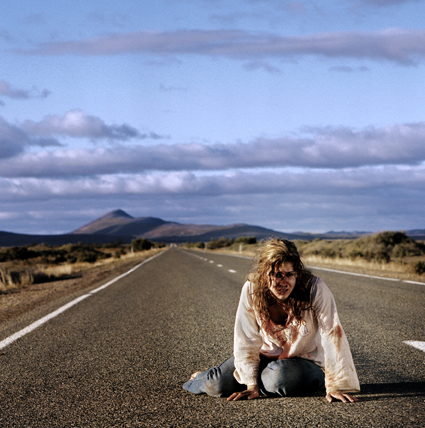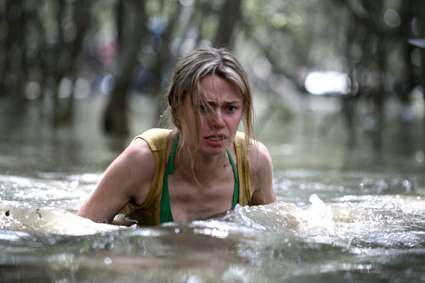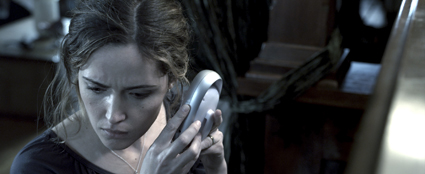the horror: how australian?
katerina sakkas: australian horror films, part one

Wolf Creek
IN SPITE OF ISOLATED EARLY EXAMPLES SUCH AS LONG WEEKEND, PATRICK (BOTH 1978) AND RAZORBACK (1984), IT’S ONLY OVER THE LAST DECADE THAT AUSTRALIAN HORROR HAS TRULY FOUND ITS VOICE, GAINING INTERNATIONAL RECOGNITION, FINANCIAL SUCCESS, GRADUAL ACKNOWLEDGMENT AND SUPPORT ON THE PART OF AUSTRALIAN GOVERNMENT FILM FUNDING BODIES. THE NUMBER OF HORROR FILMS MADE SINCE 2000 (OVER 60) IS MORE THAN THREE TIMES THE NUMBER MADE IN THE 1990S (MARK DAVID RYAN, WHITHER CULTURE? AUSTRALIAN HORROR FILMS AND THE LIMITATIONS OF CULTURAL POLICY, MEDIA INTERNATIONAL AUSTRALIA INCORPORATING CULTURE AND POLICY, NO. 133).
saw
If one film can be said to have kicked off this boom in the genre, that would be Saw (2004), the first in what has become the most commercially successful horror franchise in history. The brainchild of James Wan and Leigh Whannell, two young Melbourne filmmakers, Saw, as an Australian success story, is notable for its complete lack of ‘Australianness.’ Picked up by Lionsgate in the US after failing to secure funding in Australia, Saw is internationalised horror—horror with an American accent but no clear national identity.
Sharing certain characteristics with Se7en (1995) and Silence of the Lambs (1991), Saw takes as its focus an intelligent serial killer who wants to play a game with those involved in his crimes. Although associated with the representation of strong violence, Saw keeps its gruesomeness in context and is not deserving of the disparaging ‘torture porn’ label bestowed (often justly) upon many of its imitators. In its pared-down, grim scenario, narrative is paramount. As with many a low-budget horror film, the initial set-up is minimal: two men regain consciousness to find themselves chained by the ankle at opposite ends of a grimy industrial bathroom. Between them lies a dead man.
The more mature, self-aware of the pair, Dr Lawrence Gordan (Cary Elwes) speculates, “Whoever brought us here could have killed us by now, but they didn’t. They must want something from us. Question is, what?” A mini-cassette each man finds in his pocket provides more riddles than answers. It also introduces the film’s main narrative preoccupation: the idea of the Game. The Game takes its cue from computer games (“Game over,” the killer tells his victim at the film’s end) as well as the competitive reality TV phenomenon, where distrust is fostered and contestants can only progress at each other’s expense. There is only one ‘winner.’ In keeping with the killer’s nickname, “Jigsaw,” the Game is also a puzzle that the victim-contestants must solve, full of hidden symbols, clues and riddles.
Jigsaw’s identity is part of the puzzle for viewers and characters alike. He hides behind an array of facades and disguises, including the puppet on a trike delivering the killer’s recorded messages; the assailant in a pig-mask; and Zep, the hospital orderly whom the audience are led to believe is Jigsaw, until we discover he’s just one more participant-’player’ in the Game. Jigsaw, like Se7en’s John Doe, is a moralistic killer who perversely attempts to teach his carefully selected victims the value of life. With its emphasis on saturated colour (green and red predominate), occasional frenetically sped-up scenes, the presence of puppets and masks and tricksy narrative, Saw uses stylisation rather than naturalism to create an atmosphere of horror.
wolf creek
Though spawning a similarly ‘iconic’ serial killer, Wolf Creek (Greg McLean, 2005) differs markedly from Saw in that it’s naturalistic and undeniably Australian. Before the opening credits, portentous documentary-style captions (much favoured by horror directors) appear onscreen informing us that, “The following is based on actual events. 30,000 people are reported missing in Australia every year. 90% are found within a month. Some are never seen again.” By adopting this visual characteristic of a documentary, Wolf Creek attempts to move its scenario out of the comfort of the cinema and into the lived reality of its audience.
Wolf Creek follows a trio of backpackers—Australian Ben (Nathan Phillips), Liz (Cassandra Macgrath) and Kristy (Kestie Morassi) from England—as they drive from Broome towards Darwin, taking in Wolf Creek Meteorite Crater along the way. McLean deliberately avoids in-depth characterisation; in the manner of a fly-on-the-wall documentary, the trio exists purely in the present. In the relatively long lead-in before any violence occurs, the emphasis is on their carefree youthfulness. As if to contrast with this innocent exuberance, and to offer a presentiment of future events, McLean hints at an ugly, misogynistic side of Australia from the film’s beginning. “They get real easy when they travel,” the Broome used car salesmen tells Ben, in reference to female backpackers. Later, a group of men in an outback pub joke about “gang-banging” the girls.
When Mick Taylor (John Jarratt), the film’s monster, appears, Kristy whispers, “He’s hilarious, he’s like one of those guys from Outback Australia shows.” This observation is underlined by parallels drawn in the film between Mick and his cinematic namesake, Mick “Crocodile” Dundee, with the latter’s famous “That’s not a knife” line quoted twice. Mick Taylor is Dundee’s dark counterpart. He’s also a figure with an intentional resemblance to backpacker murderer Ivan Milat, sharing the NSW serial killer’s enthusiasm for weaponry, hunting expertise, killing methods (severing of the spine, for instance) and protruding teeth. In Mick, the beer-swilling, sexist hunter stereotype in Ted Kotcheff’s seminal 1971 film Wake in Fright is taken to its extreme.
Despite the film’s title and some vaguely mystical allusions recalling Picnic at Hanging Rock (as when watches stop in the vicinity of the crater), there’s no sense of the landscape being threatening in itself. The real horror lurks in the ugly collection of sheds that constitute Mick’s hideaway, flickeringly illuminated in the darkness; and in his rifle sights, when a sunlit road provides no cover.

Black Water
black water
Horror takes us out of our comfort zone, which for a certain sub-genre, means following urban holidaymakers into the wilderness and whatever threat awaits them there. In Wolf Creek, it’s a psychopath, in David Nerlich and Andrew Traucki’s naturalistic Black Water (2007), a crocodile. Like Wolf Creek, Black Water uses ‘documentary’ captions, tersely explaining that the Northern Territory’s saltwater crocodile population is expanding alongside its human population. It’s also “based on true events.” As with Greg McLean’s follow-up to Wolf Creek, Rogue (2007), another crocodile film, Black Water’s subject is a river tour gone wrong.
Unlike Rogue, however, which uses stunning aerial shots and an animatronic croc to awe its audience, the minimalist Black Water works more subtly, employing landscape not as mere backdrop, but as an integral part of the threat. The camera dwells on the scenery: initially, accompanied by a gently strummed score, the river seems idyllic. Later, when a crocodile (real, not animatronic) has upended the tinny and killed the guide, the surroundings transform from peaceful to sinister. The three terrified protagonists taking refuge in a mangrove tree are interlopers negotiating a hostile environment: one that won’t let them escape. This is a film that manages to do much with relatively little.

Insidious
insidious
All three sets of filmmakers are horror aficionados, but Whannell and Wan’s interest so far lies in generalised genre horror (in the manner of the Spierig Brothers, discussed in Part 2 of this article) whereas McLean, Nerlich and Traucki are concerned with developing distinctively Australian horror films. These variously draw on horrific elements of recent Australian criminal history and wildlife and the sinister potential of the landscape, as well as recalling Australian cinema classics. All continue to work in the genre: McLean has set up a production company and is working on Wolf Creek 2, and Andrew Traucki’s shark-themed The Reef was released earlier this year. With their new film Insidious (released in Australia in May) Whannell and Wan have taken their genre expertise and made what could be seen as a quintessential horror film: one designed primarily to scare.
As with Saw, Insidious is internationalised horror set in America, the only Australian element being the nationality of the female lead, Rose Byrne and of course its makers (Whannell also acts). In aspects of the art direction, certain scenes and the placement of a child at the centre of horrific events, Insidious is intentionally reminiscent of classic 1970s and 80s paranormal horror (think The Exorcist, The Shining, Poltergeist). Some of its stylisation even recalls Murnau’s Nosferatu (1922). Wan weaves these influences into a beautifully orchestrated film, which fulfils his early promise as director of Saw, demonstrating what he is capable of with a more generous budget and timeline.
Part 2 of The Horror: How Australian? will appear in RealTime 104.
RealTime issue #103 June-July 2011 pg. 15






